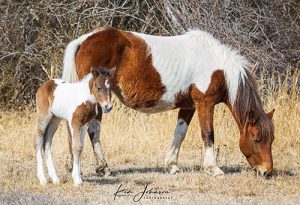
ASSATEAGUE — As if almost on cue with the arrival of March and suddenly warmer weather, a foal was born into the herd of wild horses on the Maryland side of Assateague Island last week.
While the results of November’s pregnancy tests on the eligible mares in the Maryland herd have not been released, one certainty is there will be at least one new addition this year. Early last Thursday morning, three-year-old mare Linda Rae’s Autumn Glory gave birth to an adorable filly and pictures of the new addition began circulating on social media this week.
Little else is known about the new foal and the areas in which her band frequents, and Assateague Island National Seashore staffers prefer it that way. Despite the temptation to visit and take pictures of the new foal, National Park Service officials are reminding residents and visitors everything is new to the foal and are reminded to keep a safe distance from the mare and her offspring.
As a rule of thumb, a safe distance is defined as around 40 feet, or roughly the length of a school bus. That distance is recommended for all of the wild horses on Assateague. However, because the foal is so young, the school bus rule is particularly encouraged. The new foal will learn to interact with the environment on the barrier island from other members of the band. During that time, a mare will be very protective of her foal and it is vitally important for their well-being that residents and visitors give them plenty of space.
The birth of the new foal last week comes as Assateague Island National Seashore officials continue the March census of the wild horse population on the Maryland side of the barrier island. The ideal range for the population is 80-100, but that figure has dropped into the 70-range in recent years for a variety of reasons including illness, old age, attrition and even some man-made causes.
Each November, Assateague Island National Seashore biologists conduct pregnancy tests on most of the mares in the Maryland herd to determine how many new foals are expected in the coming year and the results of those tests are not yet known.
Assateague staffers know each the mares in the herd by their alpha-numeric name, their markings, the bands they belong to and the areas of the island they tend to frequent. Although it is not entirely infallible, the pregnancy tests generally serve as a good barometer for the expected foals in the next year.

